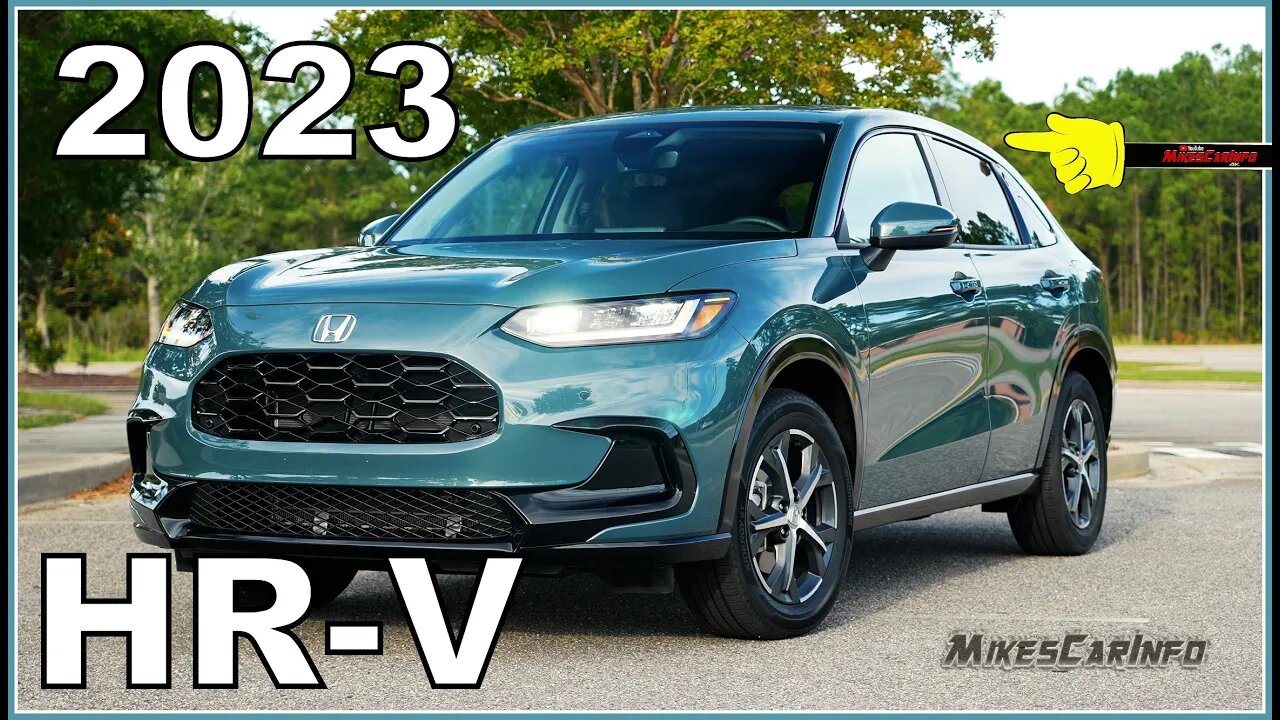Premium Only Content

2023 Honda HR-V EX-L - Ultimate In-Depth Look & Test Drive
Available in LX, Sport and EX-L
Larger and more powerful 2.0-liter 4-cylinder engine
Updated continuously variable transmission (CVT) improves response and efficiency
New Step Shift programming simulates gear changes under acceleration
Improved available Real Time AWD features enhanced traction management on snow
Honda-first Hill Descent Control is standard
Econ, Snow, Normal drive modes for custom driving experience
Larger, More Powerful Engine
Powering all HR-V grades is a new, larger 2.0-liter 4-cylinder engine producing 158-horsepower (SAE net at 6,500 rpm) and 138 lb.-ft. of torque (SAE net at 4,200 rpm). The new engine represents increases of 17 hp and 11 lb.-ft. of torque compared to the outgoing HR-V.
A new catalytic converter reduces emissions to the SULEV30 federal standard while using a minimum of rare metals. HR-V's first Idle Stop system aids fuel efficiency.
To help minimize noise and vibration, HR-V's 2.0-liter inline four has a lightweight die-cast aluminum block with a bedplate main-bearing design that creates a rigid crankcase assembly. Cast-in iron cylinder liners provide long-lasting durability. Thin slits between each adjacent cylinder sleeve help improve engine cooling and knocking.
Each journal on the lightweight heat-forged steel crankshaft is micro-polished to reduce internal friction, helping improve smoothness throughout the rpm range and lower noise levels.
Cylinder Head and i-VTEC® Valvetrain
The HR-V's standard 2.0-liter 4-cylinder engine has a lightweight DOHC cylinder head that is made of low-pressure cast aluminum alloy. With exhaust passages cast directly into the cylinder head, the need for a traditional separate exhaust manifold is eliminated and the catalytic converter mounts directly to the cylinder head.
A low-friction silent chain drives dual overhead cams which in turn operate four valves per cylinder. The cam drive is maintenance free throughout the life of the engine. To assist cooling and detonation resistance, the cylinder head has a cooling passage placed between each pair of exhaust valves.
Combustion chamber shape and valve angles are optimized to help boost fuel efficiency and power. The included valve angle is 35 degrees, to decrease the surface-to-volume ratio of the combustion chambers and help create a flat, compact combustion chamber that minimizes unburned hydrocarbon emissions. The design yields a compression ratio of 10.8:1, yet the engine still operates on regular unleaded fuel.
A high-tumble intake-port design combines with the combustion chamber and piston crown shape to create a high level of airflow tumble. This helps create a homogenous fuel mixture for fuel efficiency and high airflow for high power output.
The 2.0-liter DOHC 16-valve i-VTEC® engine uses an advanced valve control system to combine high power output with high fuel efficiency and low emissions. The system combines dual Variable Timing Control™ (VTC™), which continuously adjusts the intake and exhaust camshaft phase, with Variable Valve Timing and Lift Electronic Control (VTEC®), which changes valve lift, timing and duration of intake valve opening.
By continuously varying the timing of the intake and exhaust camshafts, VTC™ is key to the "intelligent" portion of the system. This helps increase power while also providing a smoother idle (allowing idle speed to be reduced). The cam timing is varied based on input from sensors that monitor rpm, timing, throttle opening, cam position and exhaust air-fuel ratio. The result is increased fuel efficiency and lower emissions. Under certain conditions, VTC™ can hold the intake valves open longer to allow a reverse airflow of intake air into the intake manifold, further improving efficiency.
Pistons/Connecting Rods
Designed with "cavity-shaped" crowns, the pistons in the 2.0-liter engine help maintain stable combustion and contribute to improved efficiency. To reduce weight, minimize vibration and increase operating efficiency, the lightweight pistons have a carefully optimized skirt design. Ion-plated piston rings help reduce friction for greater operating efficiency. Heavy-duty steel connecting rods with tapered small ends are heat-forged in one piece and then "crack separated" to create lighter and stronger rods with an optimally fitted bearing cap.
HR-V will be available in seven different colors, including the all-new Nordic Frost Pearl, and Urban Gray Pearl. Also available is Platinum White Pearl, Lunar Silver Metallic, Modern Steel Metallic, Crystal Black Pearl and Milano Red.
More details and specs: https://www.mikescarinfo.com/2022/07/all-new-2023-honda-hr-v.html
music by Karl Casey @White Bat Audio
-
 3:28
3:28
MikesCarInfo
1 year ago $0.01 earnedReplace Battery Nissan Key Fob -- Nissan's New Intelligent Smart Proximity Key FOB
1651 -
 LIVE
LIVE
Lofi Girl
2 years agoSynthwave Radio 🌌 - beats to chill/game to
332 watching -
 41:26
41:26
The Mel K Show
4 hours agoMel K & Clay Clark | Financial Success Hides Behind Self Discipline: Five Pillars | 8-24-25
15.3K2 -
 LIVE
LIVE
The Rabble Wrangler
12 hours agoThe Best in the West Plays Battlefield 2042 | Road to BF6 Grind
45 watching -
 LIVE
LIVE
JTtheSG
1 hour agoBack To The Deadzone!!!
59 watching -
 LIVE
LIVE
The Official Steve Harvey
12 days ago $5.07 earned24 HOURS OF MOTIVATION w/ STEVE HARVEY
372 watching -
 25:56
25:56
DeVory Darkins
21 hours ago $0.66 earnedTrump drops ULTIMATE BOMB on Democrat Mayors as ICE makes SHOCKING Announcement
40.6K169 -
 3:36:30
3:36:30
TonYGaMinG
6 hours ago🟢 ABI WITH FRIENDS | 🍩JOE DONUTS | 😶 🌫 VLADSGAMINGCARTEL |
21.3K4 -
 21:24
21:24
marcushouse
12 hours ago $0.10 earnedStarship Flight 10: Go or No? 🚀
29.8K13 -
 6:25:15
6:25:15
MrR4ger
18 hours agoSUNDAY FUNDAY w/ R4GER - VARIETY ANOTHER FCKN STREAM CRASH
24.7K